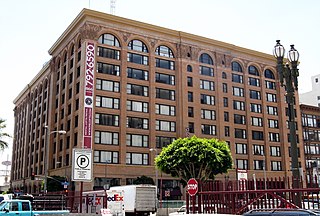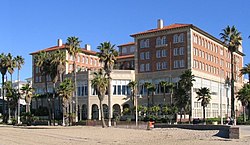
Santa Monica is a city in Los Angeles County, situated along Santa Monica Bay on California's South Coast. Santa Monica's 2020 U.S. Census population was 93,076. Santa Monica is a popular resort town, owing to its climate, beaches, and hospitality industry. It has a diverse economy, hosting headquarters of companies such as Hulu, Activision Blizzard, Universal Music Group, Lionsgate, Illumination and The Recording Academy.

The Spanish Colonial Revival style is an architectural stylistic movement arising in the early 20th century based on the Spanish colonial architecture of the Spanish colonization of the Americas.
The history of Santa Monica, California, covers the significant events and movements in Santa Monica's past.

Streamline Moderne is an international style of Art Deco architecture and design that emerged in the 1930s. Inspired by aerodynamic design, it emphasized curving forms, long horizontal lines, and sometimes nautical elements. In industrial design, it was used in railroad locomotives, telephones, toasters, buses, appliances, and other devices to give the impression of sleekness and modernity.

Mediterranean Revival is an architectural style introduced in the United States, Canada, and certain other countries in the 19th century. It incorporated references from Spanish Renaissance, Spanish Colonial, Italian Renaissance, French Colonial, Beaux-Arts, Moorish architecture, and Venetian Gothic architecture.

The historic Pacific Electric Building, opened in 1905 in the core of Los Angeles as the main train station for the Pacific Electric Railway, as well as the company's headquarters; Main Street Station served passengers boarding trains for the south and east of Southern California. The building was designed by architect Thornton Fitzhugh. Though not the tallest in Los Angeles, its ten floors enclosed the greatest number of square feet in any building west of Chicago for many decades. Above the train station, covering the lower floors, were five floors of offices; and in the top three was the Jonathan Club, one of the city's leading businessmen's clubs introduced by magnates from the Northeast. After the “Great Merger” of Pacific Electric into Southern Pacific Railroad in 1911, the PE Building became the home of Southern Pacific in Los Angeles. In 1925, a second electric rail hub, the Subway Terminal, was opened near Pershing Square to serve the north and west.
The Long Beach Museum of Art is a museum located on Ocean Boulevard in the Bluff Park neighborhood of Long Beach, California, United States.
San Vicente Boulevard is an east–west street in Santa Monica and Brentwood, in the Westside region of Los Angeles, California.
Pico Boulevard is a major Los Angeles street that runs from the Pacific Ocean at Appian Way in Santa Monica to Central Avenue in Downtown Los Angeles, California, United States. It is named after Pío Pico, the last Mexican governor of Alta California.
The western border of Santa Monica, California, is the 3-mile (4.8 km) stretch of Santa Monica Bay. On its other sides, the city is bordered by various districts of Los Angeles: the northwestern border is Pacific Palisades, the eastern border is Brentwood north of Wilshire Boulevard and West Los Angeles south of Wilshire, the northeastern border is generally San Vicente Boulevard up to the Riviera Country Club, the southwestern border is Venice Beach and the southern border is with West Los Angeles and Mar Vista.

Shutters on the Beach is a luxury hotel located on the beach in Santa Monica, California. It is owned and operated by the Edward Thomas Collection of Hotels, which also owns the adjacent Hotel Casa del Mar. A member of The Leading Hotels of the World, Shutters on the Beach offers two restaurants: One Pico and Coast Beach Café and Bar.

Santa Monica State Beach is a California State Park operated by the city of Santa Monica.
Thomas Schoos is a German-American interior designer. Born and raised in Neuerburg, Germany, Schoos currently resides in West Hollywood, California, near his design firm, Schoos Design. The Schoos Design brand was founded in 1996.

The Breakers Hotel is a historic landmark 14-story hotel on East Ocean Avenue in downtown Long Beach, California. Opened in 1926 as a luxury oceanfront resort hotel, it is set to reopen in 2024 as the Fairmont The Breakers, Long Beach. The building has gone through multiple changes of ownership and has been renamed at various times the Hilton, the Wilton, and the Breakers International Hotel. It has had a history of financial problems and closures and also operated for many years as a retirement home. The building has been designated as a Long Beach Historic Landmark.

The Hotel Alexandria is a historic building constructed as a luxury hotel at the beginning of the 20th century in what was then the heart of downtown Los Angeles. As the business center of the city moved gradually westward, the hotel decayed and gradually devolved into a single room occupancy (SRO) hotel housing long-term, low income residents and gained a reputation for crime and being unsafe. Revitalization of the area in the 21st century changed the rental practices and neighborhood safety.

The Los Angeles Pacific Railroad (1896−1911) (LAP) was an electric public transit and freight railway system in Los Angeles County, California. At its peak it had 230 miles (370 km) of track extending from Downtown Los Angeles to the Westside, Santa Monica, and the South Bay towns along Santa Monica Bay.
Jules Muck is a graffiti and mural artist based in Venice, California.

The Cosmopolitan Hotel and Restaurant in the Old Town San Diego State Historic Park is a registered national historic landmark, built in the early 19th century by Juan Bandini and later purchased by Albert Seeley to serve as a stagecoach hotel. In 2010, restorations and added fine dining restaurant revived the hotel to its 1870s charm, making it again a focal point of the original downtown area.

Santa Monica Army Air Forces Redistribution Center or Redistribution Station No.3 was a complex of buildings and hotels located in Santa Monica, California used to house troops during and after World War 2. US Army Air Force picked the Santa Monica site as Douglas Aircraft Company has a large Aerospace manufacturer operated there at Clover Field, also called Santa Monica Army Air Base). Opened in November 1943, the Redistribution opened out of leased buildings and land, most on what is now the Santa Monica State Beach. Crews rotation from Europe war and the Pacific war were able to rest and relax before their next assignment. At its peak, the complex covered 65 acres and had a staff of 1,200. Many of the staff at the center were from the Women's Army Corps. Organized social events were put on by the Santa Monica-Ocean Park chapter of the American Red Cross. At the end of the war, the complex became a processing center for troops heading home. Over 35,000 airmen had been processed at the center. Next, the complex processed prisoners of war heading home. The complex was deactivated on 15 November 1945 and the last leased building was closed in January 1947. Most of the buildings are in what is called Ocean Park, California on Ocean Avenue. The Army Air Force operated other Redistribution Centers in Atlantic City, Miami, San Antonio, Greensboro and Santa Ana, California at Camp Davis.
















